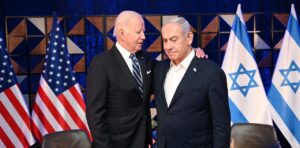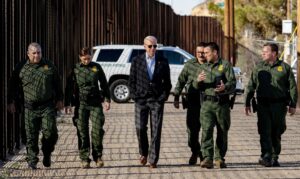In an unorthodox televised event that many read as a transparent ploy to boost the presidential aspirations of both men, last night California Gov. Gavin Newsom debated Florida Gov. Ron DeSantis. The event was billed as an epic forum to contrast ideas and opposing models for governance: what Fox News titled “The Great Red State vs Blue State Debate”. Of course, that was hardly the case. The slugfest was predictably low on substance and high on vitriol.
The debate showcased desperate attempts to create viral moments. DeSantis brought props to make his points, including a sexually explicit book aimed at children and a map that plots “the human faeces that are found on the streets of San Francisco”. Newsom, meanwhile, rarely missed an opportunity to twist the knife into DeSantis’s flailing presidential bid, repeatedly mocking his sinking polling. “When are you going to drop out and give Nikki Haley a shot to win?” Newsom jabbed.
Amid the rancour, though, there was a strange sense of clarity. Perhaps the two governors have more in common than they realise.
I’ve watched Newsom’s rise and his particular brand of politics, close-up in California. He has long baited Republican leaders with his culture-war bravado, and last night was no different. He charged that his opponent on the stage was focused on rolling back “hard-earned national rights on voting rights and civil rights, human rights and women’s rights, not just access to abortion, but also access to contraception”.
While Newsom stressed that his advocacy is a fight over the existential balance of maintaining America’s democracy, his forays into the culture war conceal a record that is hardly radical or transformative. In reality, Newsom is a moderate Democrat who has ascended to power by courting headlines and mobilising voters through the hypnotising politics of identity, but never going so far as to offend his base of wealthy donor interests.
DeSantis, for his part, has offered a mirror image to Newsom’s approach, energising conservative activists with his promise to “fight back against woke indoctrination” that he says is spreading like a “virus” in American society. With the exception of a now-abandoned push to penalise Disney, he has largely ignored major economic policy, and leaned heavily into laws that ban drag shows and curtail what he sees as excesses on university campuses. While DeSantis had some success in changing a few academic policies, most of his legislative initiatives have been blocked by the courts. Still, his crusade is broadly popular among the Republican Party base.
Jousting with Newsom, DeSantis repeatedly brought up squalor and homelessness in California, charging that Democrats threatened to bring such problems to the rest of the country. There was, however, little discussion of the particular government policies and socioeconomic trends that have driven the rampant lawlessness and homeless encampments. The Florida governor simply charged that they were examples of “Leftist ideology” and “Leftist principles”.
Maybe so, but Newsom has also hitched his fortunes on a political style that we see rising in both parties, a form of polarising culture war that captures the emotions of voters, while concealing his ambitions. In many ways he has convinced voters to see past these issues by constantly taking on more existential issues of fundamental rights and privileges, from abortion to gay rights, issues that are hardly at stake in modern California.
The pattern began early in his career. It was just months after his first election to lead San Francisco, elected in part to take on the homeless crisis in the city that Newsom issued marriage licences to same-sex couples at city hall. The gambit, though overturned by local courts, and later vindicated by the Supreme Court, was a prescient move that made him a household name and catapulted him into the good graces of social liberals — who showered him with campaign donations and adoration. Meanwhile, the problems on the streets of San Francisco, among the poor and addicted, were never seriously solved.
Then, last year, Newsom repeated a strategy he has used in the past by airing advertisements that touted the conservative credentials of a Republican opponent he saw as least likely to run a competitive campaign. The ads reminded voters that Brian Dahle, a Right-wing lawmaker, strongly supported gun rights and opposed abortion. Thanks to a quirk in the California election system, which allows open participation in primaries, the overture worked as intended. GOP voters flocked to Dahle, elevating him as the party nominee, just as Newsom had intended. The culture war blitz eliminated any real challenge to Newsom and he glided to an easy victory.
More recently, Newsom has poured millions of dollars into a Super PAC airing ads outside of California that depict the governor as the last best hope to take on Trump and a party bent on depriving women and minorities of their rights. It’s not clear how Newsom, as a governor, would play such a role outside his own state.
It’s all part of what DeSantis and many others charge is a “shadow campaign” for the presidency. In any other context, a sitting governor openly campaigning against an incumbent president of his party would provoke outrage among the party faithful. But Newsom’s pledge that he is fighting for the rights of the most vulnerable provide a convenient veneer for his blatant White House ambitions, just as his embrace of culture war issues have served his political fortunes in the past. The brazen bid is a gamble that President Joe Biden may fall ill or drop out of the campaign at some point, a potential scenario that many insiders share.
The idea of a slick California politician seizing the nomination may seem absurd. After all, the state has never looked less glittering, as DeSantis was keen to point out. Yet it is precisely Newsom’s Californian path that could help him take the helm of the modern Democratic Party. Though Newsom’s mother struggled financially, much of his life was shaped by his relationship with San Francisco’s gilded elite and its politics of balkanised identity groups. For his entire career, he has learned to navigate the interests of highly educated professionals and jet-setting philanthropists, a coalition that now calls the shots everywhere.
Rubbing shoulders with Pacific Heights socialites paid dividends from Newsom’s start in politics. The mayor at the time granted Newsom a seat on a local traffic board, then appointed him to the city council when a vacancy opened up. In many ways, it just made sense. Here was a young ambitious moderate with boundless ambition and limitless access to the city’s donor class.
When critics questioned the velvet-glove treatment, Mayor Willie Brown justified his decision as simply fulfilling a quota. ”He is young, male and appears to be straight,” shrugged Brown, a reference to the fact that city hall was bereft of white male heterosexuals. The twist on diversity, a uniquely San Francisco concern at the time, has loomed large in Newsom’s career ever since.
Look no further than Newsom’s reparations commission as an example of the weight of identity in forging his political profile. The committee has a vast mandate to study the impact of racial discrimination and slavery on black Californians, making it the most audacious effort of its type in the country. But it has no power to enact any actual policies, leaving it toothless. Newsom can campaign on the precedent and under the mantle of civil rights without any of the troubling work of cutting expensive checks to pay for historical sins.
Or take his recent appointment of Laphonza Butler to fill the seat opened by the death of Senator Dianne Feinstein. His press release touted his own pick as the “the first Black lesbian to openly serve in Congress”, with no mention of the fact that her previous experience featured lobbying for Uber and AirBnB, and as a consultant for Newsom’s own inner circle of operatives.
Channelling the vast resources of the donor class, while firing up the passions of voters with emotionally laden rhetoric around identity is certainly not limited to Newsom. But his skill in doing so goes largely unrecognised.
During the debate, Newsom repeatedly denied the claim that he is pursuing a stealth bid for the Democratic nomination. He was there, he said, to defend the country against the far right. “You and President Trump are trying to light democracy on fire,” he glared at DeSantis.
His denials betray an obvious ambition for the Oval Office, a dream he has touted behind closed doors and as early as his second year on the San Francisco supervisor board. “If you’re in politics and you want to make an impact,” Newsom told reporters in 1998, “you should be as successful as possible, and the most influential position is President.”
Disclaimer
Some of the posts we share are controversial and we do not necessarily agree with them in the whole extend. Sometimes we agree with the content or part of it but we do not agree with the narration or language. Nevertheless we find them somehow interesting, valuable and/or informative or we share them, because we strongly believe in freedom of speech, free press and journalism. We strongly encourage you to have a critical approach to all the content, do your own research and analysis to build your own opinion.
We would be glad to have your feedback.
Source: UnHerd Read the original article here: https://unherd.com/




